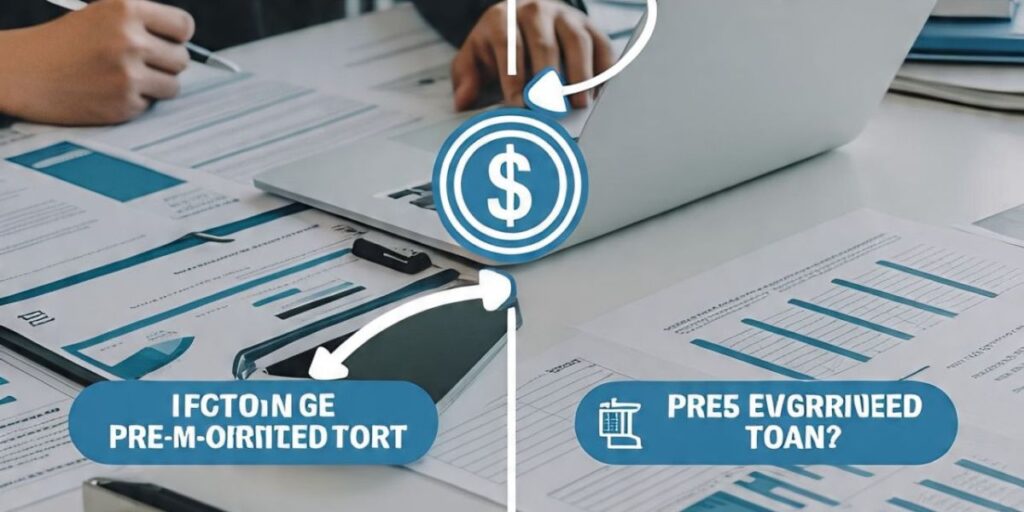So you’re thinking about getting a loan—but not just any loan. You want that pre-approved badge. It sounds reassuring, doesn’t it? Like you’ve already been given a thumbs-up from the money gods. But hang on a second… what does pre-approved mean? And how do you go about getting one?
Let’s walk through it—no fluff, no overcomplications. Just a clear, step-by-step path, especially if you’re a young guy trying to figure this stuff out for the first time.
Step 1: What Does “Pre-Approved Loan” Actually Mean?

Hint: It’s not a guaranteed ticket to cashland.
Okay, let’s kill the biggest myth first. Being “pre-approved” doesn’t mean the money’s already sitting in your account waiting for you to say yes. Think of it more like getting shortlisted. The bank’s saying, “Hey, based on what we know about you, we’d probably give you this loan. Probably.”
But the final green light? That only comes after a proper evaluation.
It’s a bit like being pre-invited to a party—you’ve got a good chance, but they still want to see if you’ll behave.
Common Myths vs. Reality:
- Myth: Pre-approval = guaranteed loan
Reality: Nope. It’s more like a conditional offer. - Myth: You can get any loan type with pre-approval
Reality: Only specific ones—usually personal, auto, or home.
So yeah, it feels good to be pre-approved. Just don’t toss your financial caution to the wind just yet.
Step 2: Check Your Credit Report—Because That’s Where the Real Judging Starts
You wouldn’t go to a job interview without knowing what your resume says, right? Same logic here. Lenders pull your credit report before they even consider pre-approving you.
Why does your credit score matter so much?
Because it tells the bank how responsible you are with money. Missed EMI payments, unpaid credit card bills, or even just a thin credit history can affect your pre-approval chances.
How can you check your score for free?
- CIBIL – India’s most popular bureau (check via OneScore or Paisabazaar)
- Experian and Equifax also offer free reports
- Bank apps like HDFC, ICICI, or SBI often show your credit score too
Pro tip: Aim for a score above 750. But if you’re hovering in the 600s, don’t panic—some lenders still consider your profile based on income stability or existing banking relationships.
Step 3: Choose the Loan That Fits You

You wouldn’t wear your dad’s oversized blazer to a first date. So don’t pick a loan that doesn’t fit your goals.
Let’s break it down:
- Pre-Approved Home Loan:
Usually based on your income and credit score. Good for when you’re house-hunting but haven’t picked a property yet. Some banks like SBI and HDFC issue these as “sanction letters” valid for a few months. - Pre-Approved Personal Loan:
Super quick. Often offered via SMS or email by banks like ICICI or Axis Bank if you have a steady salary. No collateral needed. - Pre-Approved Auto Loan:
Planning to buy your first car or a second-hand bike? These loans come with flexible tenures and decent interest rates—especially if you bank where you’re applying.
Which one should you go for?
Ask yourself: “What am I trying to solve?” Debt should solve a problem, not create one.
Step 4: Compare the Offers—Because All That Glitters Ain’t Cheap Credit
So, you’ve got multiple pre-approved offers in hand. Nice. But don’t just chase the lowest EMI like it’s a Diwali sale. Look deeper.
Here’s what matters:
- Interest Rate: Fixed or floating? Lower isn’t always better if fees are hidden.
- Processing Fee: Some banks waive this for salaried customers.
- Loan Tenure: Shorter = higher EMI but lower total interest.
- Prepayment Charges: Want to repay early without a penalty? Look for “no foreclosure fee” tags.
Where to compare?
- Websites like BankBazaar, Paisabazaar, or Bajaj Finserv
- Your bank’s net banking dashboard
- Even Google’s loan tools work well for ballpark estimates
Side note: Some fintech apps also offer personalized loan offers, but always read the fine print. Fast cash can sometimes mean fast regrets.
Step 5: Gather the Basic Docs— It’s Not as Annoying as It Sounds

You don’t need a suitcase full of files. Just the basics.
Here’s your usual checklist:
- PAN card—Identity proof
- Aadhaar—Address verification
- Last 3–6 months’ salary slips—proof
- Bank statements—To show money movement and salary credit
- Form 16 or ITR (for self-employed peeps)
Some banks even let you upload these directly through their app. Super smooth.
Step 6: Apply Online (Yes, It’s That Simple Now)
Gone are the days of standing in long bank queues with xeroxed documents. Most banks now let you apply directly through
- Net banking
- Mobile apps like HDFC Bank, Axis Bank, and ICICI Bank
- Fintech platforms like KreditBee, PaySense, or Nira
How to Apply:
- Log in to your net banking app.
- Navigate to “Offers” or “Loans.”
- Check if a pre-approved personal or car loan offer exists.
- Tap, fill, upload docs (if asked), and hit submit.
Sometimes, you’ll get approval within minutes. And disbursement? It could be same-day.
Step 7: Disbursal Time—What to Expect

The money’s been approved—now what?
Here’s how it usually flows:
- Personal Loan: Instant to 48 hours
- Auto Loan: 1–3 days
- Home Loan: 5–10 working days, depending on property verification
But wait, what if your loan gets rejected even after pre-approval?
It happens. Maybe your salary structure changed, or your credit score dipped between the offer and application. Maybe the bank found something odd in your bank statements.
What can you do?
- Contact your relationship manager and ask for clarity.
- Wait a few weeks, fix the red flags, and reapply.
- Or try a different lender entirely—comparison is your best friend.
Bonus Tip: Want More Pre-Approvals in the Future? Start Building Credibility Now
This part isn’t rocket science, but most folks ignore it until it’s too late.
Here’s what helps:
- Pay your EMIs and credit card bills on time.
- Maintain a low credit utilization ratio (ideally under 30%)
- Avoid taking too many loans at once—it sends panic signals to lenders.
- Build a relationship with your bank. Regular salary credit or fixed deposits help.
- Review your credit report every 3–6 months to fix errors.
Think of it this way: Pre-approval isn’t just about what you’ve done. It’s also about what you consistently keep doing right.
Wrapping It All Up
Getting pre-approved for a loan is honestly a lot like prepping for an exam—you’ve got to know the system, put in some groundwork, and avoid silly mistakes. The process might seem a bit technical, but once you break it down, it’s just about being organized and intentional.
And hey, don’t be that guy who gets a pre-approval and then borrows blindly. Make smart money moves, compare options, and always ask, “Do I actually need this loan—or do I just like the idea of having more money right now?”
Because sometimes, the smartest financial decision is not to take the loan at all.
But when you do? Make sure it’s the right one for you.






